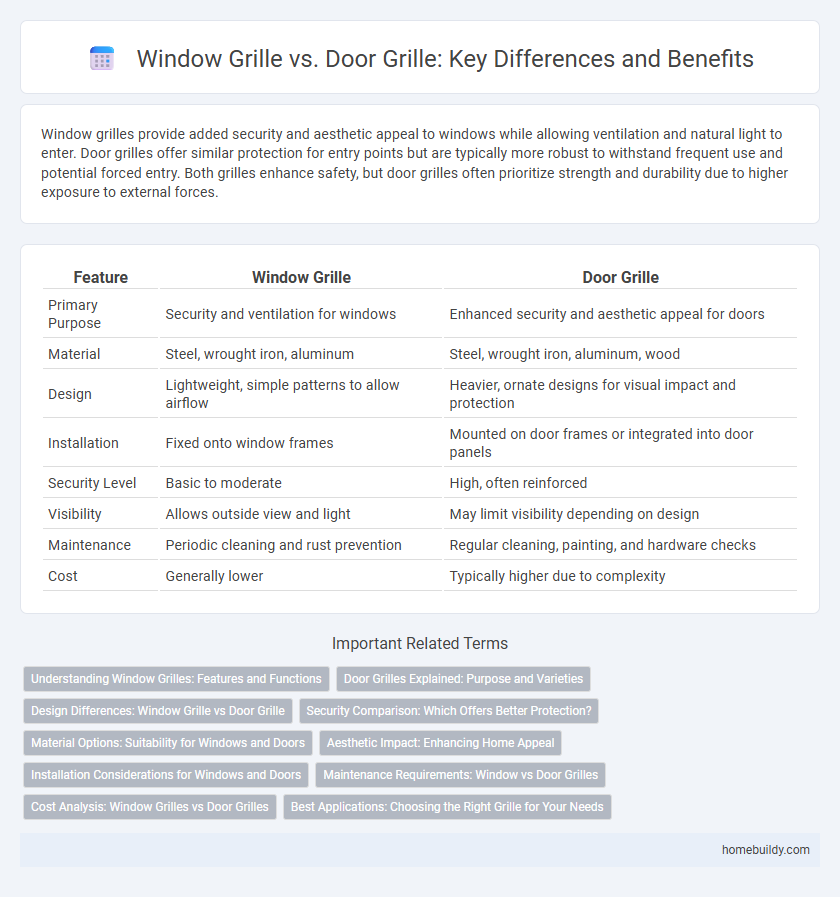Window grilles provide added security and aesthetic appeal to windows while allowing ventilation and natural light to enter. Door grilles offer similar protection for entry points but are typically more robust to withstand frequent use and potential forced entry. Both grilles enhance safety, but door grilles often prioritize strength and durability due to higher exposure to external forces.
Table of Comparison
| Feature | Window Grille | Door Grille |
|---|---|---|
| Primary Purpose | Security and ventilation for windows | Enhanced security and aesthetic appeal for doors |
| Material | Steel, wrought iron, aluminum | Steel, wrought iron, aluminum, wood |
| Design | Lightweight, simple patterns to allow airflow | Heavier, ornate designs for visual impact and protection |
| Installation | Fixed onto window frames | Mounted on door frames or integrated into door panels |
| Security Level | Basic to moderate | High, often reinforced |
| Visibility | Allows outside view and light | May limit visibility depending on design |
| Maintenance | Periodic cleaning and rust prevention | Regular cleaning, painting, and hardware checks |
| Cost | Generally lower | Typically higher due to complexity |
Understanding Window Grilles: Features and Functions
Window grilles are designed primarily to enhance security while allowing natural light and ventilation, featuring materials such as wrought iron, aluminum, or steel that resist tampering and weather elements. These grilles often have decorative patterns that complement architectural styles, serving both functional and aesthetic purposes. Unlike door grilles, window grilles are fixed or hinged for easy cleaning and maintenance, emphasizing safety without obstructing the view.
Door Grilles Explained: Purpose and Varieties
Door grilles serve as a robust security feature designed to protect entryways while allowing ventilation and visibility. They come in various forms such as wrought iron, steel, and aluminum, each offering different levels of durability and aesthetic appeal. Common types include decorative, security-focused, and sliding grilles, catering to both residential and commercial applications for enhanced safety and style.
Design Differences: Window Grille vs Door Grille
Window grilles typically feature lighter, more intricate designs to complement natural light and provide aesthetic appeal, while door grilles are sturdier with reinforced patterns to ensure enhanced security. The materials for window grilles often include thinner metal bars or decorative wrought iron, whereas door grilles prioritize robust construction with thicker bars or mesh for durability. Design differences also extend to functionality, as window grilles balance visibility and ventilation, whereas door grilles emphasize strength and entryway protection.
Security Comparison: Which Offers Better Protection?
Window grilles and door grilles both enhance security by providing physical barriers against unauthorized entry, but door grilles typically offer stronger protection due to their robust design and reinforced locking mechanisms. Window grilles often focus on preventing break-ins through glass, featuring bars spaced to deter access without obstructing ventilation or light. For maximum security, door grilles combined with solid door construction generally outperform window grilles in resisting forced entry attempts.
Material Options: Suitability for Windows and Doors
Window grilles typically use lightweight materials like aluminum or wrought iron, offering corrosion resistance and ease of installation suited for smaller, less exposed surfaces. Door grilles require sturdier materials such as steel or reinforced wrought iron to withstand frequent use and provide enhanced security against forced entry. Material selection impacts durability, maintenance, and safety, making steel ideal for doors and aluminum best suited for window applications.
Aesthetic Impact: Enhancing Home Appeal
Window grilles create a delicate framework that enhances natural light while adding architectural charm, making windows a focal point of exterior design. Door grilles offer a bold statement with intricate patterns, enhancing the entryway's visual appeal and conveying a sense of security and style. Choosing the right grille design significantly elevates curb appeal, blending functionality with artistic expression to complement the overall home aesthetic.
Installation Considerations for Windows and Doors
Window grille installation requires precise fitting within the window frame to ensure security without obstructing ventilation or natural light. Door grilles demand sturdy anchoring to withstand frequent use and potential forced entry while maintaining ease of operation. Both installations must consider material durability, weather resistance, and compliance with safety regulations for effective protection.
Maintenance Requirements: Window vs Door Grilles
Window grilles generally require less maintenance than door grilles due to their fixed position and limited exposure to frequent handling. Door grilles endure more wear and tear from constant use, necessitating regular inspections for hinges, locks, and frame stability. Both types benefit from routine cleaning and rust prevention treatments to ensure longevity and security.
Cost Analysis: Window Grilles vs Door Grilles
Window grilles typically cost less than door grilles due to their smaller size and simpler installation requirements. Door grilles often involve reinforced materials and additional design features for enhanced security, which increases their price. Comparing prices per square foot, window grilles average between $15 to $35, whereas door grilles range from $30 to $70 depending on material and customizations.
Best Applications: Choosing the Right Grille for Your Needs
Window grilles provide enhanced security and aesthetic appeal, making them ideal for preventing unauthorized entry while maintaining natural light and ventilation. Door grilles, typically sturdier and larger, are best suited for entry points requiring maximum protection without compromising visibility or airflow. Selecting the right grille depends on balancing security needs, design preferences, and functional requirements specific to windows or doors.
Window Grille vs Door Grille Infographic

 homebuildy.com
homebuildy.com